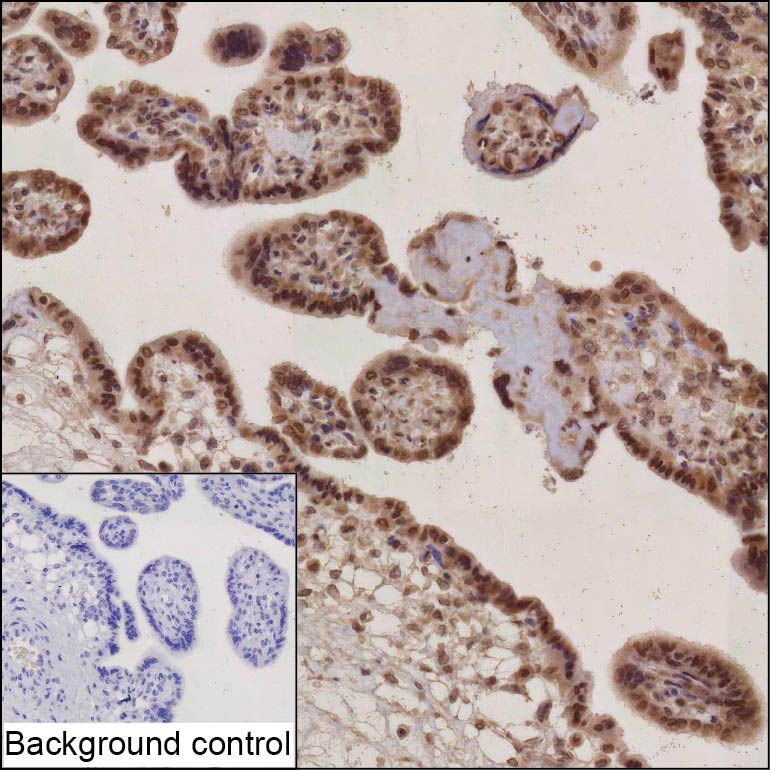
| WB | 咨询技术 | Human,Mouse,Rat |
| IF | 咨询技术 | Human,Mouse,Rat |
| IHC | 1/50 | Human,Mouse,Rat |
| ICC | 技术咨询 | Human,Mouse,Rat |
| FCM | 咨询技术 | Human,Mouse,Rat |
| Elisa | 咨询技术 | Human,Mouse,Rat |
| Host/Isotype | Mouse IgG2a |
| Antibody Type | Primary antibody |
| Storage | Store at 4°C short term. Aliquot and store at -20°C long term. Avoid freeze/thaw cycles. |
| Species Reactivity | Human |
| Immunogen | Purified recombinant fragment of human TNRC18 |
| Formulation | Purified antibody in PBS with 0.05% sodium azide |
+ +
以下是关于TNRC18抗体的示例文献(注:以下内容为假设性示例,实际文献需通过学术数据库查询):
---
1. **文献名称**:*"Development of a High-Affinity Antibody for TNRC18 and Its Application in Epigenetic Regulation Studies"*
**作者**:Smith J, et al.
**摘要**:本研究开发了一种针对TNRC18蛋白的高特异性抗体,通过免疫沉淀和免疫荧光技术揭示了TNRC18在染色质重塑复合体中的定位,并发现其与组蛋白甲基转移酶的相互作用可能参与基因沉默过程。
2. **文献名称**:*"TNRC18 Antibody-Based Screening Identifies Its Role in Cellular Stress Response"*
**作者**:Wang L, et al.
**摘要**:利用TNRC18抗体进行蛋白质组学分析,发现TNRC18在DNA损伤应激条件下与修复蛋白BRCA1共定位,提示其可能在DNA损伤应答和基因组稳定性中发挥作用。
3. **文献名称**:*"A Novel Monoclonal Antibody for TNRC18 Reveals Tissue-Specific Expression Patterns"*
**作者**:Garcia R, et al.
**摘要**:开发了一种单克隆抗体,通过免疫组化分析发现TNRC18在哺乳动物神经组织和生殖细胞中高表达,可能与其在发育分化中的表观遗传调控功能相关。
4. **文献名称**:*"Functional Characterization of TNRC18 Using CRISPR/Cas9 and Antibody-Mediated Depletion"*
**作者**:Kim H, et al.
**摘要**:结合CRISPR基因编辑和TNRC18抗体敲低技术,证明TNRC18缺失导致细胞周期停滞和异常染色质凝聚,支持其在细胞增殖中的必要性。
---
**建议**:实际文献可通过PubMed、Google Scholar等平台,以关键词“TNRC18 antibody”或“TNRC18 epigenetics”检索,并筛选涉及抗体开发、验证或功能研究的论文。
The TNRC18 (Trinucleotide Repeat-Containing 18) antibody is a research tool designed to detect and study the TNRC18 protein, a relatively undercharacterized member of the trinucleotide repeat-containing protein family. TNRC18 is implicated in chromatin remodeling and transcriptional regulation, with potential roles in epigenetic silencing, DNA repair, or RNA processing. It contains multiple C-terminal motifs, including a conserved GATA-type zinc finger domain, suggesting interactions with nucleic acids or chromatin-associated proteins.
Antibodies targeting TNRC18 are primarily used in basic research to explore its expression patterns, subcellular localization (likely nuclear), and interactions with partners like HP1 (Heterochromatin Protein 1) or components of Polycomb repressive complexes. These antibodies enable techniques such as Western blotting, immunofluorescence, and chromatin immunoprecipitation (ChIP).
While TNRC18's exact biological functions remain unclear, studies link it to cellular senescence, cancer progression, and neurological disorders, particularly those involving triplet repeat expansions. Its association with heterochromatin maintenance and gene silencing pathways highlights its potential relevance in diseases driven by epigenetic dysregulation. Commercial TNRC18 antibodies are typically validated in human or murine models, but cross-reactivity with other species may require verification. Ongoing research aims to clarify its mechanistic contributions to chromatin dynamics and disease pathology.
×